I’m going to present some facts that may surprise you. The size and strength of a rider has no bearing on his or her abilities.Either does the size or weight of the motorcycle. The fact is, to ride like a pro, and when I say “pro” I’m speaking of professional motor officers, all you need to do is master three simple techniques.
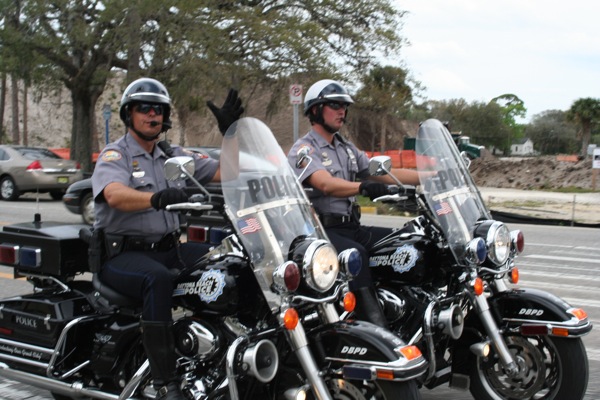
If you’ve never seen a motor officer ride, go to YouTube and type in police motorcycle competition or police rodeo and you’ll see these officers using the three techniques I’m about to reveal to you. If you are amazed at what you see and think you could never handle your motorcycle the way these police motor officers do, type in Ride Like a Pro Victoria. You’ll see a small 15-year-old girl handling an 850-pound Harley-Davidson just as easily as the motor officers.
OK, I guess you’re back, you’ve watched the clips on YouTube and now you’d like to know what this is all about. The first technique is the proper use of your head and eyes. What this phrase means, wherever you turn your head and eyes, that’s where the motorcycle will go. The reason we say head and eyes is because if you turn your head in one direction but your eyes are looking in another direction, the technique will not work.When you turn your head and eyes, your hands will soon follow and steer the motorcycle in the direction you want it to go. To ride like a professional, you must use this technique to the extreme. The faster and further you turn your head and eyes, the better it will work.
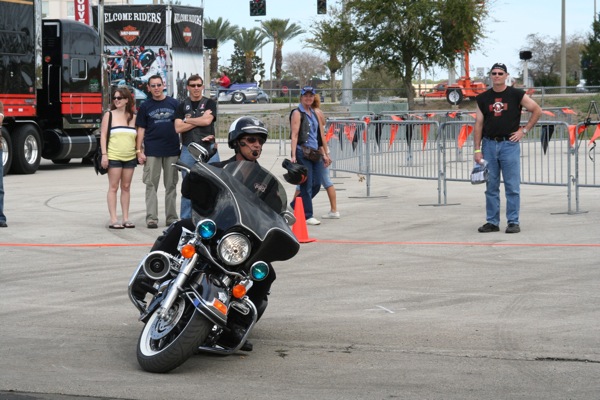
The second technique is the proper use of the friction zone.The friction zone is the area of clutch travel between completely open, (when the clutch lever is released) and completely closed, (when the lever is pulled to the grip). That gray area in between is the friction zone. You know you’re entering the friction zone when you begin letting the clutch out and feeding a little throttle, the motorcycle begins to move forward. Once you’ve let the clutch out all the way, you’ve left the friction zone. Learning to ride the motorcycle at low speeds in the friction zone will allow you to make low speed maneuvers in a smooth, easy, controlled manner.
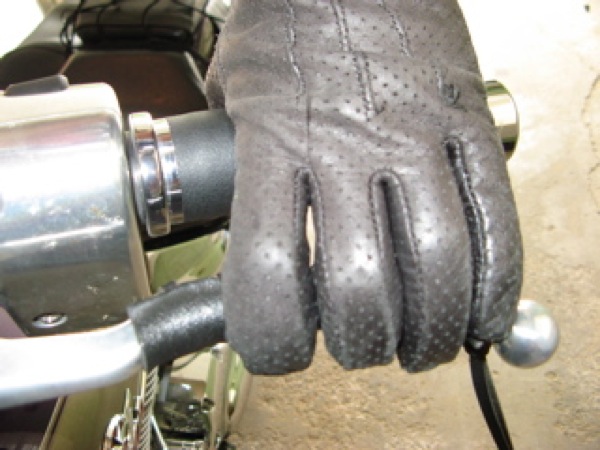
The third technique is the proper use of the rear brake. The rear brake has very little stopping force, however, if you put a little power to the rear wheel with the clutch and throttle and at the same time put a little pressure on the rear brake, it actually prevents the motorcycle from tipping over. It’s almost as if you are defying gravity. What you’re actually doing is creating more force pulling the motorcycle forward than gravity, which wants to pull the motorcycle to the ground. The best way to practice this very important skill is what’s commonly called the slow race. That is, going as slow as possible while in the friction zone with a little pressure on the rear brake and keeping your head and eyes up looking well ahead of your motorcycle. Once you find that sweet spot in the clutch travel you can actually get the motorcycle to stand completely still for a split second without tipping over.
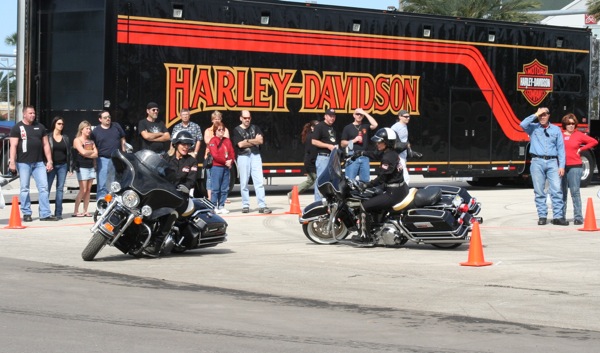
A great time to practice using the friction zone and rear brake is in heavy bumper to bumper heavy traffic. Of course, it’s best to get familiar with the friction zone in an empty parking lot under controlled conditions. You can vary your speed from just barely moving forward to a quick walking pace. As you get better with the clutch and throttle, try going as slow as possible without using any pressure on the rear brake.
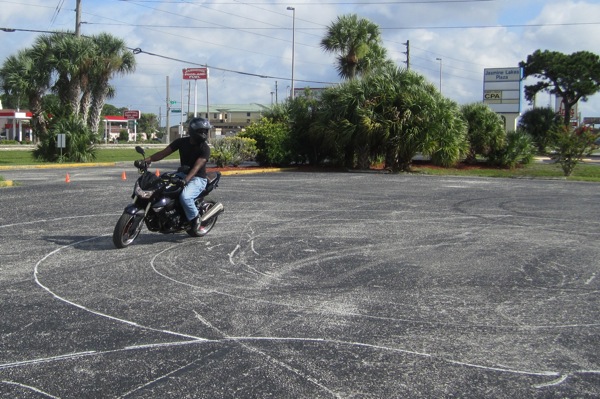
Next, try using the head and eyes technique along with the slow race. Simply, start off slowly in a straight line and turn your head and eyes quickly to the left and make a left hand turn. Don’t worry about leaning the bike at this point, in fact, try to keep the bike as straight up as possible. Now do the same thing going to the right. Next you can try making a complete circle in either direction with the motorcycle straight up and going as slow as possible. If you can do this in a circle 24 to 34 feet in circumference without putting a foot down or of course, dropping the motorcycle, you have mastered the friction zone and the rear brake. You will be amazed at how much easier it is to control your motorcycle at low speeds simply by using the three techniques I just revealed to you and practicing the slow race.
After every 5 or 10 minutes of practice give your motorcycle a breeze out. That is, simply cruise around the parking lot in 2nd gear with the clutch fully engaged and no pressure on the rear brake. This will allow the clutch and rear brake to cool down. Make sure when you are practicing the slow race to keep your revs fairly low, about twice idle speed. Pressure on the rear brake should be about 5 to 8 pounds. If you’re not sure what that is, place the ball of your foot on a bathroom scale and press down till the needle registers 5 to 8 pounds.
By the way, it doesn’t matter if you’ve heard of these techniques before; it is the degree to which you use these techniques that separates the amateur from the professional. Use the techniques a little bit and you’ll be a little bit better rider. Use the techniques to the extreme and you’ll be riding like a pro in no time.


I loved this article. My goal is to turn on a dime like my husband. Thank you for these great tips!
I have been watching YouTube videos on this and can’t wait to get the DVDs and even take a class. In southern Maryland, there is a course on this (not given by Jerry Paladino) but they are teaching his techniques and it would be very beneficial to be out on an actual course where instructors can help you to ensure you use the techniques properly.
I bought this DVD in 2008 when I was thinking about giving up riding and I will say it did make a difference. I bought a Honda 600 and practiced these tips with confidence and have since moved up to a Harley Super Glide and have never looked back. I have made W-turns with confidence and have ridden in several parades with a club that my husband and I belong to. This DVD is well worth having in your library.
I took the RLAP class in LA a month ago. I learned a lot and didn’t do nearly as well as I expected. I’ll be practicing and going back again. Definitely worth the time and effort.
I’ve been riding seven years and came upon the Ride Like A Pro when I was first starting out. I probably would have quit riding had it not been for these DVDs. The techniques taught have also helped several of my friends through their rough spots. I consider Ride Like A Pro my best “accessory.”
I have been riding for about eight seasons and still have difficulty making a sharp turn or pulling into a parking space. I plan to try these little exercises this weekend, just have to find a parking lot.
As soon as I can, I am going to get the DVD/ All I can find is #5. What happened to 1 through 4? Anyway, I want to be a GREAT rider. I just got a ’99 Kawasaki Vulcan 800 (started out on a Honda Rebel 250) and I am a little intimidated. Makes me mad at myself. I want to feel confident and I know only practice will do that. I live out in the country so there are plenty of beautiful back roads to ride on. Just need to find a paved parking lot to practice on. Wish me luck!
Ride Like A Pro #5 is a compilation of all that was contained in 1 through 4 plus a whole lot more so they don’t sell those as far as I know. Number 5 has everything you need to know.
I bought my first motorcycle, a midsized Vulcan 750 cruiser at age 55. What a blast compared to the 100cc bikes that I rode as a teenager out on the farms of my friends and cousins. Even though I have had a motorcycle license since age 14, I still took the basic riders course and discovered the three techniques that Jerry teaches here. I went back to the empty parking lot where the riding course was held, and tried riding it on my own bike a few weeks after finishing the course on a much smaller bike. I was not much surprised to find that I could not keep my tires inside the lines for the various slow riding exercises. I have purchased the Ride Like A Pro V DVD, and have a series of exercises to practice now. I know that spending an hour or so for several evenings practicing these three techniques while doing the exercises will make me a more competent and confident rider. Anybody can ride straight down the highway at 60 mph. I believe whoever it was that said, “The slow speed maneuvers separate the riders from those just along for the ride.”I wish I lived close enough to come and take the course in person. I don’t, so the DVD instruction is the next best thing. hanks for making this info and instruction available to everyone who wants it Jerry.